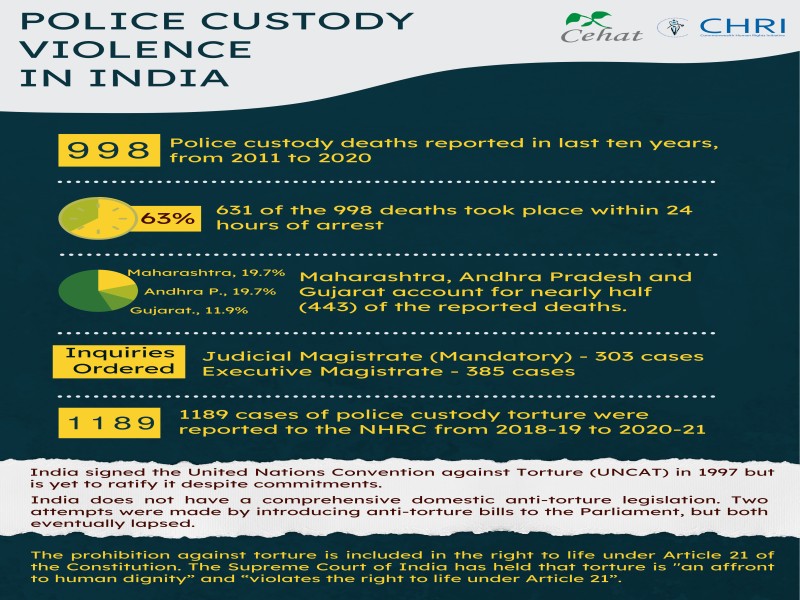CEHAT and CHRI: Urge Govt of India and NHRC to issue guidelines on medico legal examination of custodial torture and death
Mumbai/New Delhi, December 14, 2021 – The Centre for Enquiry Into Health and Allied Themes (CEHAT) and Commonwealth Human Rights Initiative (CHRI) urged the Government of India and the National Human Rights Commission (NHRC) to issue detailed guidelines in conformity with international standards on strengthening the role of health workers in detecting and documenting signs of torture, collecting evidence of it as well as offering therapeutic care.
On December 9, 2021, CEHAT and CHRI organised a webinar on ‘Medico legal examination of custodial torture and deaths’ which brought together medical and legal experts to discuss concerns as well as suggest recommendations to address torture of persons in custody. Participants also focused on subsequent deaths in custody with a deep dive on the medico legal role of health professionals.
In order to address the current lacunae in medico legal care for victims of torture and those who die in police custody, CEHAT has developed comprehensive guidelines on torture and autopsies through extensive consultations with legal and medical experts.
“Health providers have a legal obligation in the examination of victims of torture besides providing therapeutic care. The guidelines and protocols have been designed by experts and provide detailed guidance to medical providers in examination of torture as well as conduct of autopsies. We do hope that NHRC and MoHFW can incorporate them to establish standards of care and uniformity in examinations,” said Sangeeta Rege, Coordinator, CEHAT.
Jinee Lokaneeta, Keynote speaker and Professor in Political Science and International Relations at Drew University, said “These guidelines for medico legal examinations in the context of custodial violence are really an attempt to recognize the indispensable role that doctors and medical professionals play and can play in maintaining dignity and providing justice in custody.”
The guidelines provide a comprehensive framework aimed at assisting health workers detect and document torture and are adapted from guidelines developed by the United Nations, namely the 2004 Istanbul Protocol for effective investigation and documentation of Torture and the 2016 Minnesota Protocol on establishment of potentially unlawful deaths.
“The implementation of these guidelines will not only help establish custodial torture and thereby facilitate prosecution against the perpetrators but will also play an equally crucial role in helping identify measures to prevent the recurrence of torture,” said Sanjoy Hazarika, CHRI’s International Director.
Background:
Torture of persons in custody and subsequent deaths have been a long-standing concern in India. As per National Crime Records Bureau data, 998 deaths were reported in police custody in the country in the last decade. In the last three years, the National Human Rights Commission (NHRC) has received complaints of 1,189 cases of police custodial torture. Despite Constitutional and statutory safeguards, important directions from the Supreme court and subsequent guidelines issued by the NHRC to prevent torture and deaths in custody, there has been little change. Many of those in custody continue to face unabated torture. The police are rarely held accountable for their actions.
Health professionals have a critical role to play in detecting signs of torture, collecting evidence of it as well as offering therapeutic care. Yet, many health professionals are neither adequately qualified or resourced, nor have guidance and clarity of their responsibilities in these cases. In addition, there are no guidelines in India to uncover signs of torture that can assist them to identify and document the issues.
Similar concerns exist with the examination of custodial deaths and subsequent autopsies. If autopsies are conducted in a comprehensive and scientific manner they offer powerful evidence related to abuse in custody. NHRC, through its guidelines on custodial deaths, has laid down procedures regarding immediate intimation about a custodial death, and timely submission of relevant documents relating to the death to the Commission, amongst others. Recently, the Commission issued a ‘model form’ to examine and document custodial deaths. Though this is a step in the right direction, the model form is inadequate to document important details regarding custodial deaths.
-------
For further details, contact:
Sangeeta Rege , CEHAT sangeetavrege@gmail.com
Raja Bagga, Senior Programme Officer, Police Reforms raja@humanrightsinitiative.org
